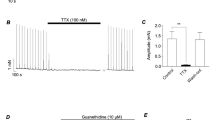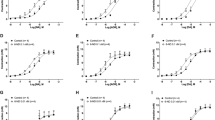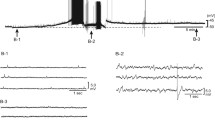Summary
-
1.
The process by which the activation of presynaptic α2-adrenoceptors inhibits the release of noradrenaline from terminals of postganglionic sympathetic nerves was studied in the mouse isolated vas deferens. Clonidine was used as a prototypic agonist. Field stimulation-evoked excitatory junction potentials (e.j.p.s) were recorded from individual muscle cells. The e.j.p. amplitudes were taken as a measure of transmitter release.
-
2.
Changes in the external Ca2+ concentration from 2.5 to 1.25 or 5 mM caused corresponding changes in the size of e.j.p.s. When the normal Ca2+ concentration of the medium (2.5 mM) was substituted by equimolar quantities of Ba2+ or Sr2+, the e.j.p. amplitudes decreased considerably.
-
3.
Clonidine (0.3–30 nM) inhibited the nerve stimulation-evoked e.j.p. amplitudes in a concentration-dependent manner, without altering appreciably the frequency of spontaneous e.j.p.s. Procedures known to enhance Ca2+ entry into nerve terminals, like a high Ca2+ medium (Ca2+ 5 mM) or 4-aminopyridine 30 μM reduced the effect of clonidine. Repetitive nerve stimulation at 3 Hz, which is supposed to lead to an accumulation of free Ca2+ inside nerve terminals, similarly counteracted the effect of clonidine 10 nM. Whereas the α2-adrenergic inhibition of the first e.j.p. in a train was unaffected, the inhibition of all successive e.j.p.s was gradually decreased. At 5 mM Ca2+ only the time-course of facilitation became faster, the decrease in α2-adrenergic inhibition proceeded with the same pulse-dependent rate as at a normal external Ca2+ concentration, although from a lower initial level.
-
4.
Procedures known to decrease the efflux of K+ from the nerve terminal, like a high K+ medium (K+ 12 mM) or Ba2+ 100 μM, depolarized the smooth muscle and enhanced the effect of clonidine on the e.j.p.s. In a low Ca2+ high K+ medium (Ca2+ 1.25 mM, K+ 12 mM) the potentiation of the clonidine effect was slightly smaller than at a normal Ca2+ concentration of 2.5 mM.
-
5.
It is suggested that α2-adrenoceptor activation may decrease Ca2+ entry through voltage-sensitive channels into terminals of postganglionic sympathetic nerves and in consequence inhibit nerve stimulation-evoked transmitter release. Our results do not agree with an indirect modulation of axoplasmic Ca2+ or a blockade of action potential propagation by a potassium permeability increase in the terminal axon.
Similar content being viewed by others
References
Adams DJ, Smith SJ, Thompson SH (1980) Ionic currents in molluscan soma. Ann Rev Pharmacol 3:141–167
Aghajanian GK, VanderMaelen CP (1982) α2-Adrenoceptor hyperpolarization of locus coeruleus neurons: intracellular studies in vivo. Science 215:1394–1396
Bennett MR, Florin T (1975) An electrophysiological analysis of the effect of Ca ions on neuromuscular transmission in the mouse vas deferens. Br J Pharmacol 55:97–104
Blakeley AGH, Cunnane TC, Petersen SA (1982) Local regulation of transmitter release from rodent sympathetic nerve terminals? J Physiol 325:93–109
Brown DA, Dunn PM, Marsh S (1982) Possible electrophysiological mechanisms for modulating transmitter release. In: de Belleroche J (ed) Presynaptic receptors: Mechanism and function. Ellis Horwood, Chichester, pp 207–218
Cunnane TC, Stjärne L (1982) Secretion of transmitter from individual varicosities of guinea-pig and mouse vas deferens: all-ornone and extremely intermittent. Neuroscience 7:2565–2576
Cunnane TC, Stjärne L (1984) Frequency dependent intermittency and ionic basis of impulse conduction in postganglionic sympathetic fibres of guinea-pig vas deferens. Neuroscience 11:211–229
Dismukes K, de Boer AA, Mulder AH (1977) On the mechanism of alpha-receptor mediated modulation of 3H-noradrenaline release from slices of rat brain neocortex. Naunyn-Schmiedeberg's Arch Pharmacol 299:115–122
Drew GM (1978) The effect of different calcium concentrations on the inhibitory effect of presynaptic α2-adrenoceptors in the rat vas deferens. Br J Pharmacol 63:417–419
Dunlap K, Fischbach GD (1978) Neurotransmitters decrease the calcium component of sensory neurone action potentials. Nature 276:837–839
Dunlap K, Fischbach GD (1981) Neurotransmitters decrease the calcium conductance activated by depolarization of embryonic chick sensory neurones. J Physiol 317:519–535
Eccles JC, Krnjevic K (1959) Potential changes recorded inside primary afferent fibers within the spinal cord. J Physiol 149:250–273
Egan TM, Henderson G, North RA, Williams JT (1983) Noradrenaline-mediated synaptic inhibition in rat locus coeruleus neurones. J Physiol 345:477–488
Furness JB (1970a) The excitatory input to a single smooth muscle cell. Pflügers Arch 314:1–13
Furness JB (1970b) The effect of external potassium ion concentration on autonomic neuro-muscular transmission. Pflügers Arch 317:310–326
Galvan M, Adams PR (1982) Control of calcium current in rat sympathetic neurons by norepinephrine. Brain Res 244:135–144
Göthert M (1977) Effect of presynaptic modulators on Ca2+-induced noradrenaline release from cardiac sympathetic nerves. Naunyn-Schmiedeberg's Arch Pharmacol 300:267–272
Holman ME, Taylor GS, Tomita T (1977) Some properties of the smooth muscle of the mouse vas deferens. J Physiol 266:751–764
Horn JP, McAffee DA (1979) Norepinephrine inhibits calciumdependent potentials in rat sympathetic neurons. Science 204:1233–1235
Horn JP, McAffee DA (1980) Alpha-adrenergic inhibition of calcium-dependent potentials in rat sympathetic neurones. J Physiol 301:191–204
Illes P, North RA (1982) Effects of divalent cations and normorphine on spontaneous excitatory junction potentials in the mouse vas deferens. Br J Pharmacol 75:599–604
Illes P, Rubini P (1984) Mechanisms of inhibition by opioids and α2-adrenoceptor agonists of noradrenaline release. In: Vizi ES, Magyar K (eds) Regulation of transmitter function: Basic and clinical aspects. Akademiai Kiado, Budapest, pp 163–173
Illes P, Starke K (1983) An electrophysiological study of presynaptic α2-adrenoceptors in the vas deferens of the mouse. Br J Pharmacol 78:365–373
Illes P, Thesleff S (1978) 4-Aminopyridine and evoked transmitter release from motor nerve endings. Br J Pharmacol 64:623–629
Illes P, Zieglgänsberger W, Herz A (1980) Calcium reverses the inhibitory action of morphine on neuroeffector transmission in the mouse vas deferens. Brain Res 191:511–522
Langer SZ, Dubocovich ML, Celuch SM (1975) Prejunctional regulatory mechanisms for noradrenaline release elicited by nerve stimulation. In: Almgren C, Carlsson A, Engel J (eds) Chemical tools in catecholamine release. II. Elsevier, North-Holland, Amsterdam, pp 183–191
Morita K, North RA (1981) Clonidine activates membrane potassium conductance in myenteric neurones. Br J Pharmacol 74:419–428
Nakamura S, Tepper JM, Young SJ, Groves PM (1981) Neurophysiological consequences of presynaptic receptor activation: changes in noradrenergic terminal excitability. Brain Res 226:155–170
Plant TD, Standen NB, Ward TA (1983) The effects of injection of calcium ions and calcium chelators on calcium channel inactivation in Helix neurons. J Physiol 334:189–212
Rogawski MA, Barker JL (1983) Effects of 4-aminopyridine on calcium action potentials and calcium current under voltage clamp in spinal neurons. Brain Res 280:180–185
Schauf CL, Colton CA, Colton JS, Davis FA (1976) Aminopyridines and sparteine as inhibitiors of membrane potassium conductance: effects on Myxicola giant axons and the lobster neuromuscular junction. J Pharmacol Exp Ther 197:414–425
Standen NB (1981) Ca channel inactivation by intracellular Ca injection into Helix neurones. Nature 293:158–159
Starke K (1981) Presynaptic receptors. Ann Rev Pharmacol Toxicol 21:7–30
Starke K, Montel H (1974) Influence of drugs with affinity for α-adrenoceptors on noradrenaline release by potassium, tyramine and dimethylphenylpiperazinium. Eur J Pharmacol 27:273–280
Stjärne L (1978) Facilitation and receptor-mediated regulation of noradrenaline secretion by control of recruitment of varicosities as well as by control of electro-secretory coupling. Neuroscience 3:1147–1155
Thesleff S (1980) Aminopyridines and synaptic transmission. Neuroscience 5:1413–1419
Tokimasa T, Morita K, North A (1981) Opiates and clonidine prolong calcium-dependent after-hyperpolarizations. Nature 294:162–163
Vizi ES (1983) Release-modulating adrenoceptors. In: Kunos G (ed) Adrenoceptors and catecholamine action, part B. Wiley and Sons, New York, pp 65–107
Wall PD (1958) Excitability changes in afferent fiber terminations and their relation to slow potentials. J Physiol 142:1–21
Williams JT, Egan TM, North RA (1982) Enkephalin opens potassium channels on mammalian central neurones. Nature 299:74–77
Williams JT, Henderson G, North RA (1984) Locus coeruleus. In: Dingledine R (ed) Brain slices. Raven Press, New York, pp 297–312
Yeh JZ, Oxford GS, Wu CH, Narahashi T (1976) Dynamics of aminopyridine block of potassium channels in squid axon membranes. J Gen Physiol 68:519–535
Author information
Authors and Affiliations
Rights and permissions
About this article
Cite this article
Illes, P., Dörge, L. Mechanism of α2-adrenergic inhibition of neuroeffector transmission in the mouse vas deferens. Naunyn-Schmiedeberg's Arch. Pharmacol. 328, 241–247 (1985). https://doi.org/10.1007/BF00515548
Received:
Accepted:
Issue Date:
DOI: https://doi.org/10.1007/BF00515548




